

Climate change’s deadliest effects are unfolding under the sea. Think of the dangers climate change poses to animals, and you’ll likely picture skinny polar bears or cliff-diving walruses (collective sob).
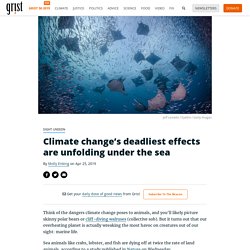
But it turns out that our overheating planet is actually wreaking the most havoc on creatures out of our sight: marine life. Sea animals like crabs, lobster, and fish are dying off at twice the rate of land animals, according to a study published in Nature on Wednesday. The researchers looked at more than 400 cold-blooded animals on land and sea, including lizards, dragonflies, lobsters, and mussels.
Insect collapse: ‘We are destroying our life support systems’ “We knew that something was amiss in the first couple days,” said Brad Lister.
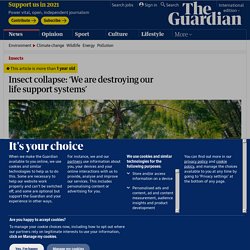
“We were driving into the forest and at the same time both Andres and I said: ‘Where are all the birds?’ There was nothing.” His return to the Luquillo rainforest in Puerto Rico after 35 years was to reveal an appalling discovery. The insect population that once provided plentiful food for birds throughout the mountainous national park had collapsed. The Insect Apocalypse Is Here. Near the center of the old city, a paper sign, not much larger than a business card, identifies the stolid headquarters of the society whose research caused so much commotion.
Insect Decimation Upstages Global Warming. Everybody’s heard about global warming.
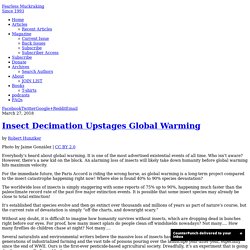
It is one of the most advertised existential events of all time. Who isn’t aware? However, there’s a new kid on the block. An alarming loss of insects will likely take down humanity before global warming hits maximum velocity. Half the Coral in the Great Barrier Reef Has Died Since 2016. Once upon a time, there was a city so dazzling and kaleidoscopic, so braided and water-rimmed, that it was often compared to single living body.

Sea Turtles Under Threat as Climate Change Turns Most Babies Female. In Brief Since sea turtle sex is influenced by the temperature at which the egg is incubated, climate change is ensuring that nearly all sea turtles in warm northern Australia are being born female.
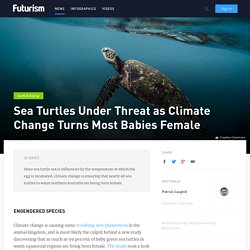
Engendered Species Using a new, non-invasive hormone test, the researchers from the U.S. National Oceanic and Atmospheric Administration (NOAA) Fisheries Department and the Queensland Department of Environment and Heritage Protection found that while 65 -69 percent of the turtles from the southern region were female, between 86.8 and 99.8 of turtles tested in the northern region were female, depending on age. The sex of green sea turtles, along with some other species of turtles, crocodiles, and alligators, is not regulated by the introduction of sex chromosomes at key points during early development, as seen in humans and other mammals.
Warning of 'ecological Armageddon' after dramatic plunge in insect numbers. The abundance of flying insects has plunged by three-quarters over the past 25 years, according to a new study that has shocked scientists.
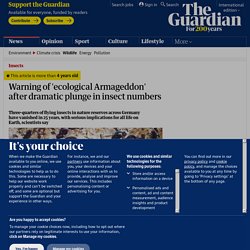
Insects are an integral part of life on Earth as both pollinators and prey for other wildlife and it was known that some species such as butterflies were declining. A Coral Reef Revival - The Atlantic - The Atlantic. David Vaughan works on the Florida Reef Tract, the third largest coral reef in the world and a vastly important ecosystem for sustaining underwater life.
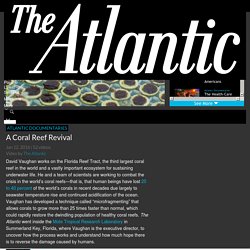
He and a team of scientists are working to combat the crisis in the world’s coral reefs—that is, that human beings have lost 25 to 40 percent of the world’s corals in recent decades due largely to seawater temperature rise and continued acidification of the ocean. Vaughan has developed a technique called “microfragmenting” that allows corals to grow more than 25 times faster than normal, which could rapidly restore the dwindling population of healthy coral reefs.
The great nutrient collapse. Irakli Loladze is a mathematician by training, but he was in a biology lab when he encountered the puzzle that would change his life.
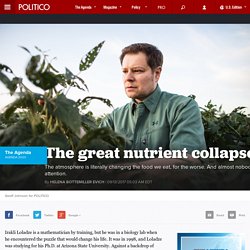
It was in 1998, and Loladze was studying for his Ph.D. at Arizona State University. Against a backdrop of glass containers glowing with bright green algae, a biologist told Loladze and a half-dozen other graduate students that scientists had discovered something mysterious about zooplankton. Zooplankton are microscopic animals that float in the world’s oceans and lakes, and for food they rely on algae, which are essentially tiny plants. Scientists found that they could make algae grow faster by shining more light onto them—increasing the food supply for the zooplankton, which should have flourished.
But it didn’t work out that way. Climate Change Is Forcing Trees to Move Northwest - The Atlantic. As the consequences of climate change strike across the United States, ecologists have a guiding principle about how they think plants will respond.
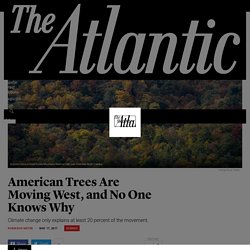
Cold-adapted plants will survive if they move “up”—that is, as they move further north (away from the tropics) and higher in elevation (away from the warm ground). A new survey of how tree populations have shifted over the past three decades finds that this effect is already in action. But there’s a twist: Even more than moving poleward, trees are moving west. About three-quarters of tree species common to eastern American forests—including white oaks, sugar maples, and American hollies—have shifted their population center west since 1980. The Great Barrier Reef: a catastrophe laid bare. It was the smell that really got to diver Richard Vevers.
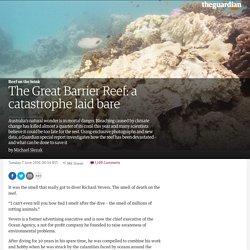
The smell of death on the reef. “I can’t even tell you how bad I smelt after the dive – the smell of millions of rotting animals.” Vevers is a former advertising executive and is now the chief executive of the Ocean Agency, a not-for-profit company he founded to raise awareness of environmental problems. After diving for 30 years in his spare time, he was compelled to combine his work and hobby when he was struck by the calamities faced by oceans around the world. Chief among them was coral bleaching, caused by climate change. His job these days is rather morbid. What_an_invasive_species_in_nepal_tells_us_about_our_climate_future. © 2009 Jeevan Jose/Wikimedia Commons Nepal’s Chitwan National Park, a stretch of grasslands, forests, and wetlands in the humid foothills of the Himalayas, is home to an enormous diversity of plants and animals.
A UNESCO World Heritage Site, the park provides refuge to Bengal tigers and some of the last of the world’s single-horned Asiatic rhinoceroses, among other endangered species. Fish Stocks Are Declining Worldwide, And Climate Change Is On The Hook. A fisherman shovels grey sole, a type of flounder, out of the hold of a ship at the Portland Fish Pier in Maine, September 2015. New research finds the ability of fish populations to reproduce and replenish themselves is declining across the globe.
The worst news comes from the North Atlantic, where most species are declining. Gregory Rec/Portland Press Herald via Getty Images hide caption toggle caption Gregory Rec/Portland Press Herald via Getty Images.
The Apocalypse Project. BIODIVERSITY: A Tipping Point on Species Loss? Biodiversity, Climate Change, Development & Aid, Energy, Environment, Global Geopolitics, Global Governance, Headlines, North America, Poverty & MDGs, World Stephen Leahy - Humanity is destroying the network of living things that comprise our life support system. While this sawing-through-the-branch-we’re-perched-on is largely unintentional, world leaders can’t say they didn’t know what’s going on: 123 countries promised to take urgent action in 2003 but have done little to stem the rising tide of extinctions in what’s known as the extinction or biodiversity crisis. Species are going extinct at 1,000 times their natural pace due to human activity, recent science has documented, with 35 to 40 species vanishing each day, never to be seen again.
“The question of preserving biological diversity is on the same scale as climate protection,” German Chancellor Angela Merkel said in a speech in Berlin Monday at the official launch of the United Nations’ International Year of Biodiversity. The Latest Buzz on Bees. Illustration by Rafael Ricoy A beekeeper's discovery could help save our honeybees from a massive die-off About five years ago, researchers studying colony collapse disorder, the syndrome in which most of the honeybees in a colony die or disappear without warning, discovered a new potential culprit: a fungal pathogen called Nosema ceranae.
While they didn't believe it was the sole cause of colony collapse disorder, or CCD, evidence suggested that it played a part in this epidemic, which has had severe effects on American agriculture. (Honeybee pollination is responsible for a third of the food we eat; crops that rely on it are valued at $15 billion annually.) Dealing with the consequences of climate chance inaction: the impact of food - History Future Now. In a previous article History Future Now admitted defeat: climate change is happening and there is no viable political solution which will enable us to stop it from getting worse.
Global average temperatures will rise beyond the 2 degrees that politicians have determined is the absolute maximum that it should be allowed to increase by. We need to stop worrying about how to prevent it from getting worse and start concentrating on what governments need to do manage this new reality. In this article we will look at the impact of global and local food shortages, exasperated by climate change, and how governments should respond. Climate Change Is Turning Your Produce Into Junk Food. Biodiversity: Life – a status report. Earth lost 50% of its wildlife in the past 40 years, says WWF.
Researcher says sixth mass extinction is here. Stanford Report, June 19, 2015 Paul Ehrlich and others use highly conservative estimates to prove that species are disappearing faster than at any time since the dinosaurs' demise. By Rob Jordan Stanford Woods Institute for the Environment.